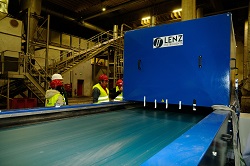New sorting techniques hold promise for metal recyclers
The SHREDDERSORT (Selective recovery of non-ferrous metal automotive shredder by combined electromagnetic tensor spectroscopy and laser-induced plasma spectroscopy) project harnesses two technologies to offer a new way of sorting non-ferrous metals, one which will allow the sorting process to take place automatically and at high speed. The project, led by Spanish SME Lenz Instruments, could improve the recycling of high-value metals such as aluminium, copper and bronze from vehicle scrap and reduce the demand for raw materials. When cars and other vehicles come to the end of their useful life, they are chopped into pieces around 1 - 10 cm in size by shredder plants to facilitate recycling and disposal. Separating the ferrous metals from the pieces using magnets is relatively simple, according to Jacobo Alvarez, project coordinator and R&D Manager at Lenz Instruments. But sorting the remaining matrix of non-ferrous metals is a lot harder. Existing methods such as wet separation are expensive to manage and use large amounts of water. Using x-ray fluorescence sensors, a more recent approach, works well but can only separate metals of the same density. New sorting techniques The SHREDDERSORT team is using electromagnetic tensor spectroscopy to analyse the electrical properties of the scrap at different frequencies. They then combine the resulting data with information on the morphology of the scrap fragments to determine their conductivity. Since different metals have different levels of conductivity, this allows them to be sorted. They have developed a second sorting technology based on laser-induced breakdown spectroscopy or LIBS. ‘While this technique is well known in the laboratory, using it in a high-speed sorting system is technologically challenging,’ says Dr Alvarez. The SHREDDERSORT system sends metal fragments along a one-metre-wide conveyor belt at a speed of two metres per second. Two short, high power laser pulses are fired at each fragment as it passes by, ablating a small mass from its surface and generating a plasma plume at an extremely high temperature. As the plasma cools, a high-speed spectrometer identifies the different aluminium alloys by measuring the characteristic emission lines of elements in the ablated material. Air ejectors then take care of the sorting. ‘As a result of this work, we have been able to demonstrate that our system can sort cast and wrought aluminium alloys with an accuracy above 90 %,’ says Dr Alvarez. Operational since April 2016, the LIBS system can handle a throughput of up to two tonnes per hour. Good timing This innovation comes at the right moment. Currently most aluminium scrap, both cast and wrought, is recycled to produce secondary cast aluminium. But as early as 2018, the supply of cast aluminium will begin to outstrip demand, while demand for purer wrought aluminium scrap to produce secondary wrought aluminium alloys is expected to rise. The SHREDDERSORT team now aims to fine-tune its system to produce one which is robust enough to withstand the harsh operating conditions to be found in recycling plants. This calls for redesigning some of the critical elements of the system and the project’s industrial partners are exploring ways to fund this step. ‘The use of these technologies is not limited to processing automotive metal scrap. The technology could be easily adapted to the recovery of target metals from industrial, electronic or any other type of waste which contains metal,’ says Dr Alvarez.







